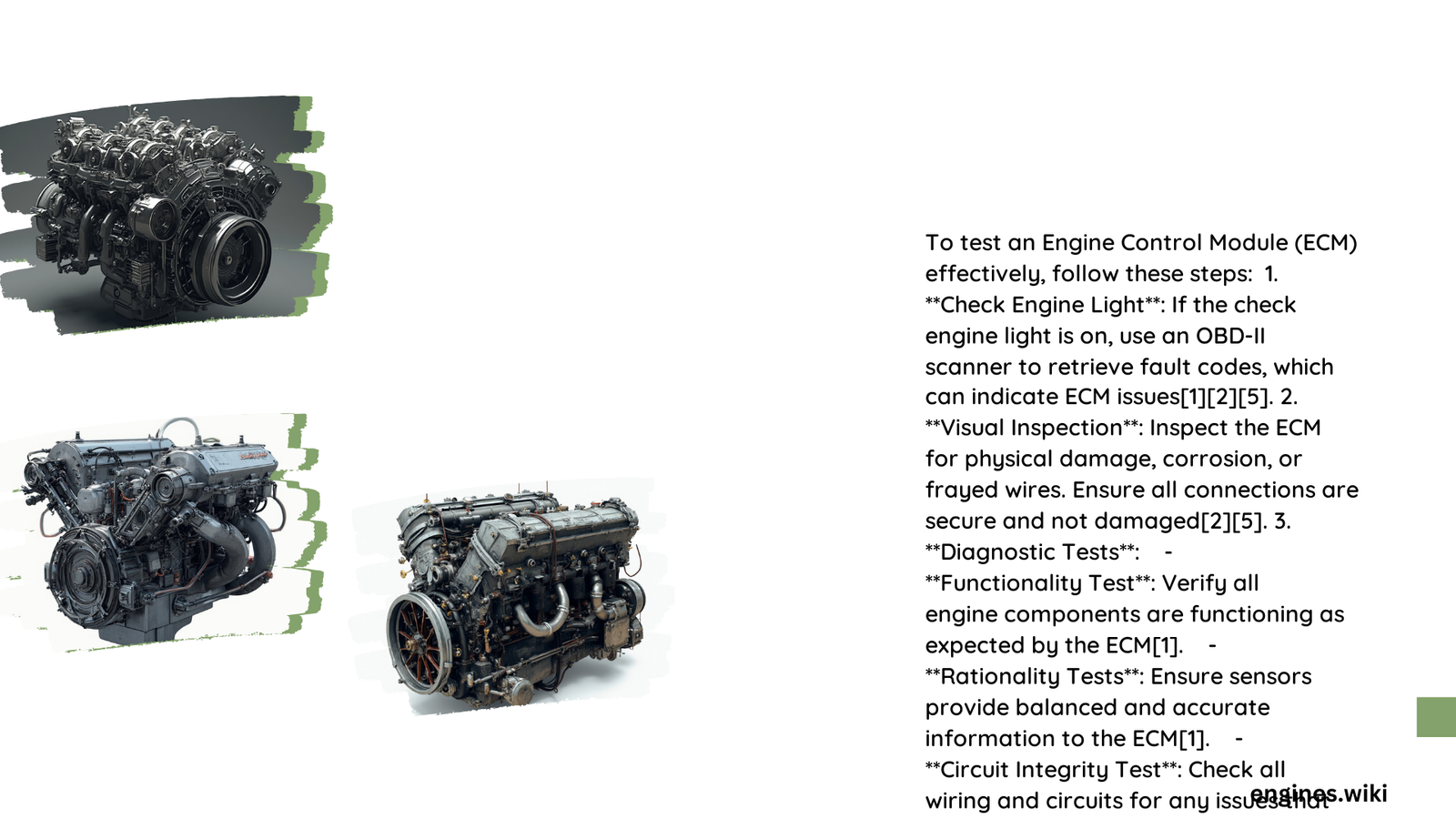Engine control module testing is a critical process in vehicle diagnostics that involves assessing the functionality and performance of the ECM, which is responsible for managing various engine functions. This process includes visual inspections, electrical measurements, and diagnostic procedures using specialized tools. Effective ECM testing can identify issues ranging from faulty sensors to internal module failures, helping to maintain optimal engine performance and fuel efficiency.
What are the Key Steps in Engine Control Module Testing?
Engine control module testing involves several crucial steps to accurately diagnose and resolve issues:
- Visual Inspection
- Electrical Testing
- Diagnostic Scanning
- Performance Analysis
Let’s delve into each of these steps in detail.
1. Visual Inspection
The first step in engine control module testing is a thorough visual inspection. This involves:
- Removing the ECM from its housing
- Checking for physical damage or signs of overheating
- Inspecting connectors and wiring for corrosion or loose connections
- Examining the circuit board for burnt components or visible defects
A visual inspection can quickly reveal obvious issues such as water damage or electrical shorts that may be causing ECM malfunction.
2. Electrical Testing
What Tools are Needed for Electrical Testing?
To perform electrical testing on an engine control module, you’ll need:
- Digital Multimeter
- Oscilloscope (for advanced testing)
- Wiring diagrams specific to the vehicle
How to Perform Basic Voltage Checks?
- Set your multimeter to DC voltage mode
- Connect the black probe to a good ground point on the vehicle chassis
- Use the red probe to test various pins on the ECM connector
- Compare readings to specifications in the vehicle’s service manual
| Pin Function | Expected Voltage Range |
|---|---|
| Power Supply | 11.5V – 14.5V |
| Sensor Input | 0V – 5V (typically) |
| Ground | < 0.1V |
3. Diagnostic Scanning
What Information Can be Gathered from OBD-II Scanning?
OBD-II scanning is a crucial part of engine control module testing. It provides:
- Diagnostic Trouble Codes (DTCs)
- Live data streams from sensors
- Freeze frame data at the time of fault occurrence
To perform a diagnostic scan:
- Connect an OBD-II scanner to the vehicle’s diagnostic port
- Turn the ignition to the ‘ON’ position (engine off)
- Follow the scanner’s prompts to retrieve codes and data
- Analyze the information to identify potential ECM issues
4. Performance Analysis
How to Assess ECM Performance in Real-Time?
Performance analysis involves:
- Road testing the vehicle
- Monitoring live data parameters
- Observing engine response to various conditions
Use a scan tool with graphing capabilities to:
- Monitor fuel trim adjustments
- Observe throttle response
- Check for smooth transitions in engine operating modes
What are Common ECM Fault Codes and Their Meanings?

Understanding fault codes is crucial in engine control module testing. Here are some common ECM-related codes:
- P0600-P0606: ECM/PCM related codes
- P0700-P0799: Transmission control system codes
- P1xxx: Manufacturer-specific codes
Example:
– P0601: Internal Control Module Memory Check Sum Error
– P0606: ECM/PCM Processor Fault
How to Interpret Voltage Readings During ECM Testing?
Interpreting voltage readings is a critical skill in engine control module testing:
- Power Supply Voltage:
- Normal: 12-14.5V
- Low: Possible battery or charging system issue
-
High: Potential voltage regulator failure
-
Sensor Inputs:
- 0-5V range for most analog sensors
-
Fluctuating voltages indicate active sensor operation
-
Ground Circuits:
- Should read less than 0.1V
- Higher readings suggest poor grounding
What are the Costs Associated with ECM Testing and Replacement?
The costs of engine control module testing and potential replacement can vary:
| Service | Estimated Cost Range |
|---|---|
| Diagnostic Fee | $75 – $150 |
| ECM Replacement (Part) | $300 – $2000+ |
| Labor for Replacement | $50 – $200 |
Factors affecting cost:
– Vehicle make and model
– Complexity of the ECM
– Labor rates in your area
How Long Does ECM Testing and Replacement Typically Take?
The time required for engine control module testing and replacement can vary:
- Basic Diagnostic Testing: 1-2 hours
- Comprehensive Testing: 2-4 hours
- ECM Replacement: 1-3 hours (depending on vehicle)
Factors influencing time:
– Accessibility of the ECM
– Complexity of the vehicle’s electrical system
– Need for programming or coding of the new ECM
What are the Signs of a Failing ECM?
Recognizing the signs of a failing ECM is crucial for timely testing and replacement:
- Check Engine Light is on
- Engine stalling or misfiring
- Poor fuel economy
- Starting problems
- Erratic engine performance
If you notice these symptoms, it’s important to perform engine control module testing promptly to prevent further issues.
How Often Should ECM Testing be Performed?
Regular engine control module testing is not typically part of routine maintenance. However, it’s recommended to have the ECM checked:
- When persistent engine problems occur
- After any major electrical work on the vehicle
- If the vehicle has been exposed to water damage
- Every 100,000 miles as a preventive measure
By following these guidelines, you can ensure your vehicle’s ECM is functioning optimally and catch potential issues before they lead to major problems.
Remember, engine control module testing is a complex process that often requires specialized knowledge and equipment. While some basic checks can be performed by DIY enthusiasts, comprehensive testing and ECM replacement are best left to qualified professionals.
